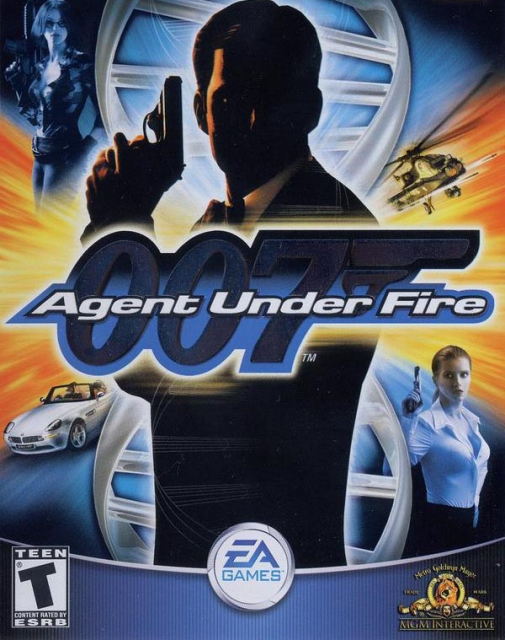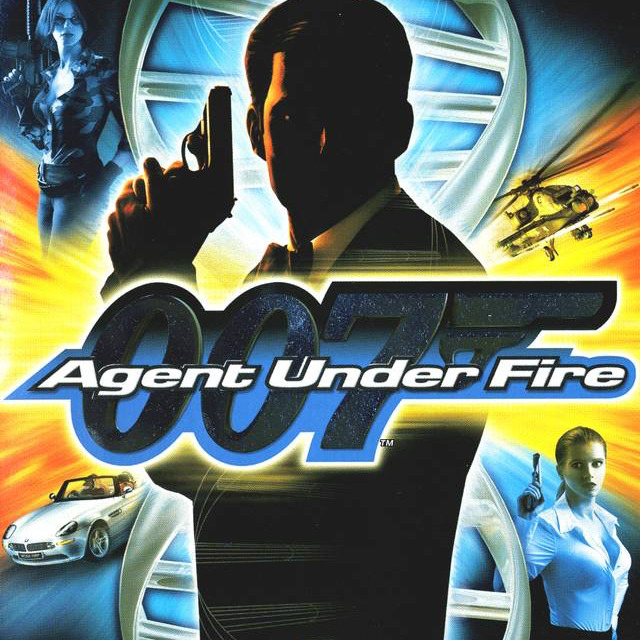Welcome to The Top Shelf, a weekly feature wherein I sort through my extensive PS2 collection for the diamonds in the rough. My goal here is to narrow down a library of 185 games to a svelte 44: the number of spaces on my bookshelf set aside for my PS2 collection. That means a whole lot of vetting and a whole lot of science that needs to be done - and here in the second round, that means narrowing our laser focus to one game per week (at least). Be sure to check out the Case File Repository for more details and a full list of games/links!
Extra Note: We've entered Shelftember! In this much-vaunted month, we will be processing one of the second round entries every day. I'll be spending one hour apiece with each game - inspired by DanielKempster's backlog-clearing series "An Hour With..." - and determining its fate from there.

The legacy of Rare's GoldenEye 007 is a little more involved than just its "Aztec, 5 minutes, Power Weapons" quick-to-assemble, party-ready, four-person multiplayer. That's what's endured most, of course, but GoldenEye also ingeniously found a way to turn standard FPS gameplay into something more befitting the sneaky and resourceful MI6 agent we love to... tolerate in spite of his antiquated gender politics? I guess? Where are we at with that? Anyway, GoldenEye had Bond infiltrate various locations from the Pierce Brosnan movie of the same name (though not necessarily ones he himself actually visited in the film) and reach an end point while gunning down Janus's henchpeople and keeping himself alive through regularly replacing body armor and making ample use of cover and stealthy subterfuge. More striking than that, however, were the spy objectives Bond was given to complete: place a tracker on a helicopter, destroy alarms before they could be set off, minimize civilian casualties, and so on. These gave the non-linear levels a little more depth and provided strong narrative reasons for Bond to be there, rather than exist as a set of inconsequential corridors and rooms to serve as a backdrop for projectile-based violence. This format also had players replaying missions over and over to figure out the fastest way to complete all objectives and reach the end, picking out routes and working around or through enemy patrols and fixed encounters as quickly as humanly possible. This was all in service to the time trials, which unlocked new cheats for players to mess around with.
When EA picked up the license with the intent to continue where Rare left off, they produced the pale shadows of GoldenEye that were 007: Tomorrow Never Dies and 007: The World is Not Enough (which, fittingly, were slightly worse movies too). They followed a lot of the same beats but lacked that character and sense of purpose. It wasn't until EA got off the movie tie-ins with 007: Agent Under Fire that they settled into a pattern of what they saw as ideal James Bond games: you can shoot stuff, you can drive stuff, but the greatest returns came from doing cool spy shit with finesse. The game introduces the masterstroke that is the "Bond move": particular actions and opportunities, usually set-up in the level beforehand, where Bond does something cool or resourceful and the player is rewarded a little Bond musical sting (this little guy) for his efforts. This can involve anything from shooting an explosive barrel near some entrenched armed henchmen to quickly take them out of the fight, deactivating a laser tripwire via Q's gadgets instead of just leaping over it, using the car's smoke emitters to lose a tail, taking out a door gunner from a helicopter with precision aiming, and other smooth moves along those lines. Each stage has a specific number of these, and they're the closest thing the game has to collectibles.
Each of the game's levels are fairly short too. I was able to get through four of them in my allotted hour, which is apparently also 1/3 of the game's total content. Also, like the hour spent with yesterday's Crash Bandicoot: The Wrath of Cortex, it was enough to provide a decisive demonstration of what the game had to offer: the first mission was your traditional action-packed infiltration, the second was a rail shooter where a friendly NPC was driving a vehicle and Bond took to the sunroof with an assault rifle to eliminate pursuers (you got a free "Bond move" every time you took out the tires instead of the driver or shooter), the third placed Bond in the driving seat and relied on navigating the streets of Hong Kong using the various car gadgets to elude your enemies, and the fourth was a stealth mission where you had to quietly (or quickly) take out guards before they raised an alarm. By doing well enough in a mission - which rates the player based on accuracy, ammo conservation, damage taken, enemies incapacitated, the number of Bond moves they found, and the difficulty they were playing on - the player could then unlock cheats to make subsequent playthroughs of that mission and those of a similar format that much easier. Unlocking cheats also gives you the confidence to try those missions on higher difficulties for bigger payouts, and therein lies the secret to the game's longevity in spite of how easy it was to blow through a large fraction of its content in under an hour. Each time you beat a mission, you learn how you could've done it better and faster, and with each new cheat - which includes the likes of infinite ammo and increased accuracy on the auto-aim - you make it even easier on yourself to take down the later, tougher missions. It's an elegant system and perhaps the best way a designer could've built on what GoldenEye started.
With regards to its quality as a shooter in general, it's a little uneven until you take the time to "fix" the game by switching to one of its alternate control schemes. The default control scheme puts firing your gun on one of the face buttons, and has the left stick dedicated to movement and rotation while the right stick is camera control and strafing. I can't even begin to describe how weird it is to play a game with the sticks assigned that way, though fortunately the game's presets include one where the sticks do what they're supposed to and the aim/fire are assigned to the L1 and R1 triggers respectively. I'm not sure why that wasn't the default - maybe the game was going for a unique controller set-up to distinguish itself from its contemporaries? Or it was a holdover from the N64 era? - but it only took five minutes of hopelessly spinning around and walking into walls before I opted to reload and course-correct. It still has that early console FPS issue of being almost impossible to precision-aim at anything, but it also includes a generous auto-aim to account for that. It's not ideal if, for example, you're trying to shoot a cable holding up a crate above an enemy for a Bond move bonus or anything equally fancy, but if you're thick in the fight with multiple opponents and you just want some basic center-mass auto-aim then it's there for you.
It's a snappy game that rarely sits around in one location for longer than ten minutes, and quickly cycles through various game modes to maintain your interest level. The highscore-gated cheats, which I'm so thankful no longer rely on time trials (time taken to complete a mission is part of the final score, but hardly as significant as the Bond moves and the kill count), add an extra layer of longevity to the game's bite-sized missions, and its plot can be as deliciously moronic as it wants without having to work itself around a movie that has more time to breathe and deliver exposition and establish characters. Were it not for the amount of hacking involved, Agent Under Fire is practically a Roger Moore Bond movie in game form.
Result: Progresses to the Final Round.

Log in to comment